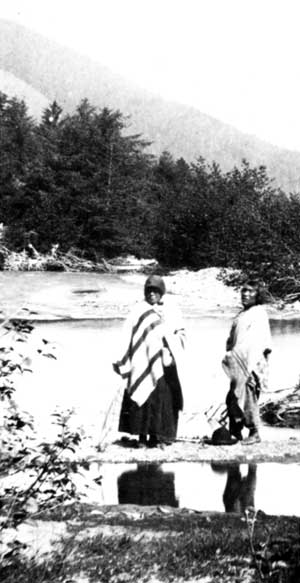|
SITKA
Administrative History |

|
Chapter 1:
DESCRIPTION OF THE RESOURCE
| INTRODUCTION |
|
|
Overview
This section describes the area now known as Sitka National Historical Park. It discusses its geographic location, environment, component resources such as Indian River, the Indian fort site, the battleground, the Russian sailors' memorial, the totem poles, the cultural center, the Russian Bishop's House, the Russian blockhouse, recreational usage, and their values, and the significance assigned to those values. It examines the intent of executive and congressional actions taken in the 1890s and early 1900s to reserve the area.
Geographic location
Sitka National Historical Park lies adjacent to, and because of "outholdings" such as the Russian Bishop's House and the Russian blockhouse, actually in, the Southeastern Alaska fishing and lumber processing port of Sitka.
Sitka, with its population of approximately 8,000, is the largest community on the west coast of 1,607-square-mile Baranof Island. It is also the fourth largest community in Alaska. It is 95 air miles southwest of Juneau, 185 air miles northwest of Ketchikan, 590 air miles southeast of Anchorage, and almost 900 air miles north of Seattle. [1]
Physical Environment
Although it lies on the eastern edge of the North Pacific Ocean, Sitka is sheltered from the violence of those waters by Sitka Sound. Around Sitka is the rainforest-like vegetation typical of Southeastern Alaska. This dense growth of Sitka spruce, western hemlock, and Alaska cedar rises to timberline on the steep slopes of the Baranof Mountains. Various berry bushes, devil's club, and other undergrowth form a dense cover for the forest floor. Alpine tundra is found above treeline, typically around 2,000 feet.
Moisture-laden clouds moving in from the ocean dump about 97 inches of precipitation, including 50 inches of snow, on Sitka each year. This heavy, but sporadic, rain and snowfall is complemented by strong south or southeasterly winds with average annual speeds of eight to ten knots. Temperatures range from the 40s to the 60s in summer and from the teens to the low 40s in winter.
Natural wildlife found in the Sitka area includes bear, deer, mink, and otter. Other wildlife that has been introduced by human intervention includes mountain goats, martens, and squirrels. Sea mammals, such as sea otter, were once plentiful in the Sitka vicinity but were hunted to near extinction in the nineteenth century. Other sea mammals such as harbor seals, sea lions, porpoises, and several species of whales have survived in the waters near Sitka. Ocean fish indigenous to the Sitka area include sockeye, chum, pink, and coho salmon and numerous types of bottom fish. Fresh water fish in the area include steelhead, rainbow, cutthroat trout, and Dolly Varden. Other sea life nearby includes Dungeness, tanner, and king crab; clams, scallops, abalone, sea urchins, octopus, and sea cucumbers. [2]
Cultural Environment
The Sitka area is historically the location of a large Tlingit Indian year-round village. That complex and rich culture was supplemented and impacted by Western culture in the late eighteenth century when Russian fur traders arrived both to trade and later to occupy the area. The Battle of Sitka, commemorated by the park, in fact resulted in the Kiksadi Tlingits leaving the Sitka area for some twenty years. The Kiksadi eventually returned to Sitka at the invitation of the Russians. The Russians themselves were later supplanted by Americans who arrived in October of 1867 to occupy the Russian posts there and in other areas of Alaska.
Thus Sitka's cultural environment is a mixture of Tlingit, Russian, and American cultures. That mixture is reflected in the variety of resources that have been identified over the years in what is now Sitka National Historical Park.
| <<< Previous | <<< Contents>>> | Next >>> |
sitk/adhi/adhi1.htm
Last Updated: 04-Nov-2000
